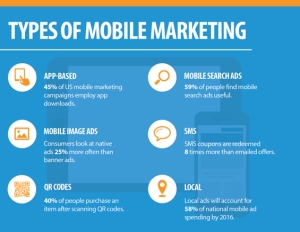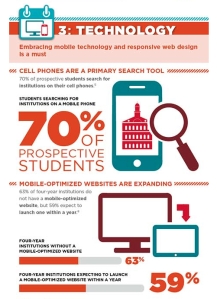The world of higher ed marketing is traditionally slower to respond, adopt and adapt new technologies when it comes to recruiting students. However, mobile marketing is one area that many universities, including Tennessee Tech, cannot afford to be behind the ball on. With the internet now in everyone’s pocket, especially the 15-17 year old demographic, universities and colleges need to take advantage of this technology to communicate directly with students. Below is a summary of articles detailing these new trends for 2014 and why mobile marketing has become so increasingly important.
Mobile Marketing Watch — Infographic — What’s Driving Mobile Marketing in 2014?
This dynamic infographic details 25 statistics that will drive the future of mobile marketing, including that there were 1.4 billion smartphones in use in 2013, and that 57% of users won’t recommend brands with poor mobile sites. Below is a screen capture on the different types of mobile marketing: app-based, mobile image ads, QR codes, mobile search ads, SMS and local.
CMO.com by Adobe — Slide Show: Top 11 Marketing Trends for 2014
This slide show dives into why in today’s instant-download world, your web strategy has to be mobile first design (responsive design). In my opinion, the strong trends in mobile marketing do herald the eventual end of the traditional desktop computer and with it, web banner advertising. Companies and universities alike have to start thinking of mobile first in terms of how a user experiences their brand online; same goes for advertising and content. Today’s content must be “snackable” and easy to digest on the go — so less text, more video/photo/graphics. Another good slide here details the evolution of the “brand newsroom” or experiencing a brand in real time. The best example of this is for brands to participate in nationwide events, like the SuperBowl — kind of like you have to show up to the party to be noticed. Brands can follow and participate with customers during the event by reaching out via social media.
CIO.com — 6 Mobile Marketing Trends to Leverage in 2014
This article outlines the following trends to make the most of when it comes to mobile marketing: increase personalization and customization of messages, employ location-based marketing, use narrowcasting, develop multimedia messaging service and rich media messaging, create even shorter content (micro content) and the gamification of mobile ads will continue. The most applicable trends for higher ed found here include the increased personalization and customization of messages and narrowcasting. Personalization is not a new trend — it’s been well known that more custom messages (using student names and interests) in custom printed pieces, like direct mail, have a better response rate, so the same would hold true for mobile. Narrowcasting was a new term for me here. It refers to the process by which brands target fewer individuals who are more qualified versus casting a wide demographic net. With today’s focus on retention, this is important in student recruitment — you want to recruit the students most likely to graduate, so target the high-achieving students.
Higher Education Marketing — The Year in Higher Education Marketing: Trends of 2013
This slide show also emphasized the importance of responsive web design (making your site mobile friendly) and emphasizing that this strategy of mobile first is part of brand management. You need to make sure your site is not just presented to fit the dimensions of mobile, but also prioritized so that the most important information is easily accessible by the end user. We’ve recently undergone this process with the ongoing development of a new university website (https://newcms.tntech.edu/). We developed both a desktop design and a mobile design. You can even see the mobile part in action by downsizing your browser. Information presented is coded for hierarchy, and as it gets smaller, you can see the most important content gets shifted to the top.
Hobsons Education Blog — Top 4 Higher Education Trends of 2013 plus Infographic
The four trends presented here focus on: the increasing difference in student demographics, the importance of demonstrating value in times of of increased competition and declining enrollment, embracing mobile technology and responsive web design is a must and that social media and texting can help foster personal connections with students. Below is a screen capture of some of the more interesting statistics on mobile technology, including that 70% of prospective students are searching universities on their mobile phones.

